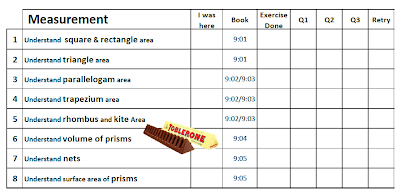Tonight was parent-teacher night at my school for Year 8 - the year group I'm trying Standards Based Grading with. On a hunch, I brought some copies of the quizzes we do and the little SBG Grid I hand out to all my students to stick in their exercise books when we start each new topic:
Each time I showed this grid during our parent-teacher interviews, the benefits of this system for parents became clearer and clearer to me.
Here are some classic parent concerns - and how an outcomes tracking system helps address them:
- "How can I monitor how my child is doing?"
It's easy! Open your child's exercise book, find the page with the grid - you can see exactly where we are up to, what marks they are getting for each outcome. - "How can I provide more help to my child?"
Find their outcome grid, see where they are having difficulty - look at the book reference, ask for more resources specifically relating to that topic. - "How can I get more homework?"
Look at the book reference to find more exercises for that outcome, or ask for extra quiz sheets. - "How can I help my child revise for the end of year test?"
Find the grid for each topic, now you have a list of all the outcomes for that topic.
One parent greeted me with the words: "I hear you have been doing continuous assessment" - I nearly fell off my chair in surprise at the jargon before I realised this parent was also a teacher! We laughed - and I was so grateful for her explaining to me in such simple terms what I was really doing with my system. Standards Based or not - it almost (*) doesn't matter what assessment approach I'm taking - the most vital aspect is it's continuous feedback. Not waiting until the end of the topic, the end of the term to find out what is going on. Having students regularly update their outcomes grid while the topic is being learned gives their parents a direct window into their child's learning and specific information on where and how they can help.
Looking back on it, I never really thought about parents when doing SBG (apart from being concerned how they might react to the idea) - I always saw it in terms of the value for students and teachers. But now I see how SBG can help parent-child and parent-teacher learning conversations. The benefits for parents are so strong, I'm accelerating my push to do SBG with another year group - to have the system in place before it's time to meet their parents!
* Using SBG actually does matter - because with SBG, when a parent sees their child did not reach an outcome, something can be done about it : the parent can work with or encourage the child to master the outcome and then retake the quiz, and thus improve the grade mark for that outcome. With SBG, outcomes can be re-attempted many times and will upgrade the score given.
* Using SBG actually does matter - because with SBG, when a parent sees their child did not reach an outcome, something can be done about it : the parent can work with or encourage the child to master the outcome and then retake the quiz, and thus improve the grade mark for that outcome. With SBG, outcomes can be re-attempted many times and will upgrade the score given.









